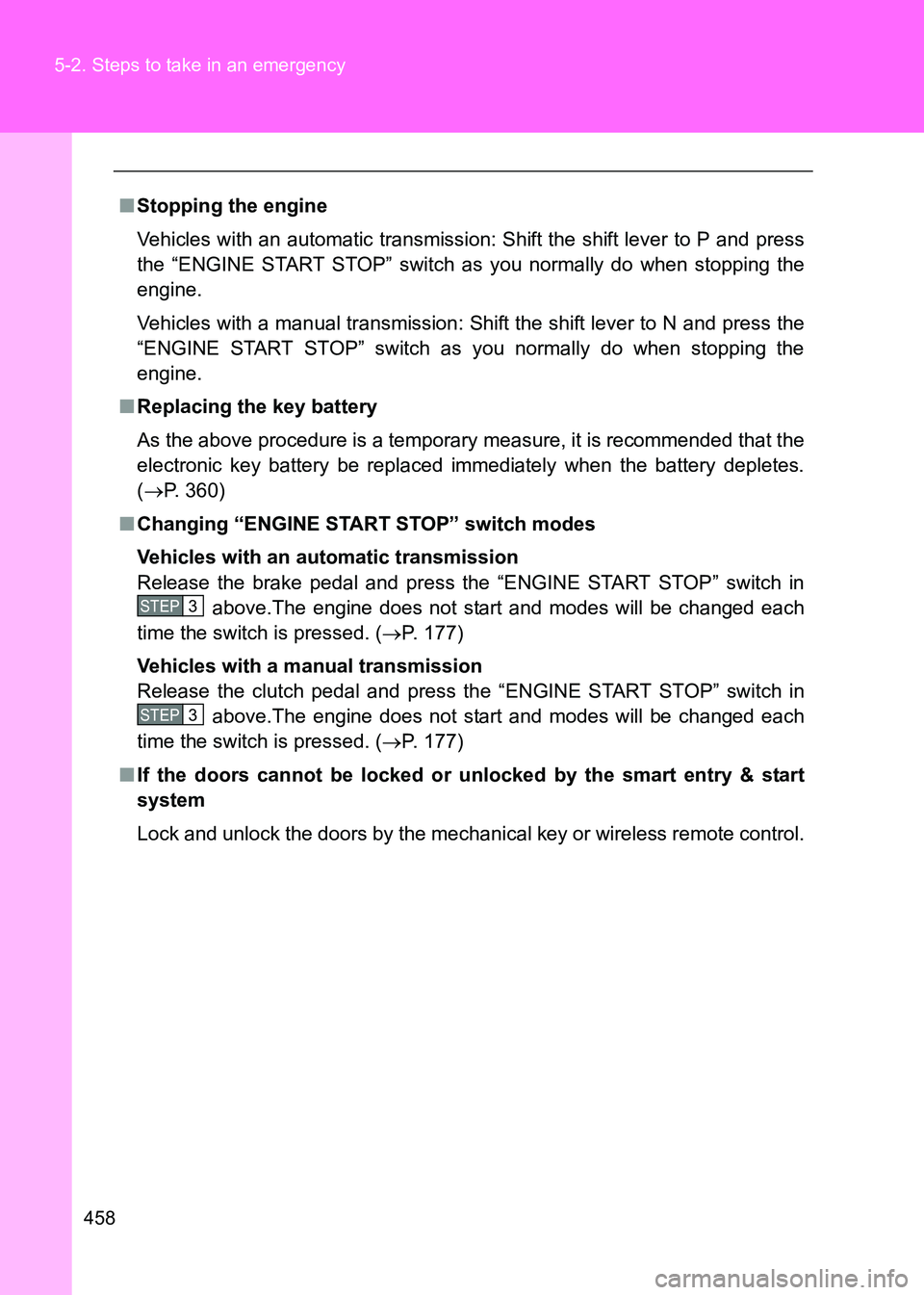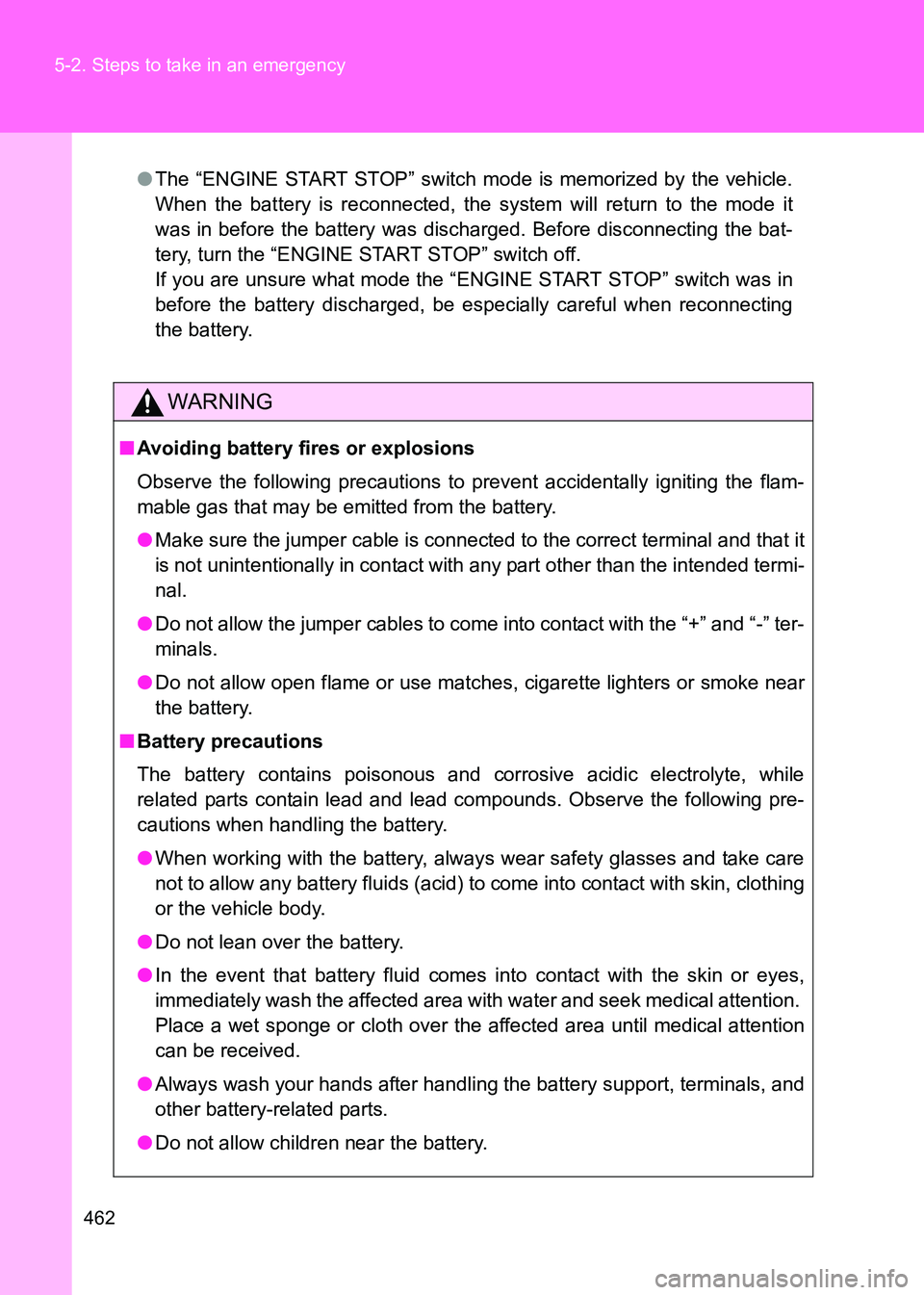Page 458 of 505

458
5-2. Steps to take in an emergency
86_EE (OM18071E)
■
Stopping the engine
Vehicles with an automatic transmission: Shift the shift lever to P and press
the “ENGINE START STOP” switch as you normally do when stopping the
engine.
Vehicles with a manual transmission: Sh ift the shift lever to N and press the
“ENGINE START STOP” switch as you normally do when stopping the
engine.
■ Replacing the key battery
As the above procedure is a temporary measure, it is recommended that the
electronic key battery be replaced immediately when the battery depletes.
( → P. 360)
■ Changing “ENGINE START STOP” switch modes
Vehicles with an automatic transmission
Release the brake pedal and press the “ENGINE START STOP” switch in
above.The engine does not start and modes will be changed each
time the switch is pressed. ( →P. 177)
Vehicles with a manual transmission
Release the clutch pedal and press the “ENGINE START STOP” switch in above.The engine does not start and modes will be changed each
time the switch is pressed. ( →P. 177)
■ If the doors cannot be locked or unlocked by the smart entry & start
system
Lock and unlock the doors by the mechanical key or wireless remote control.
STEP 3
STEP 3
Page 460 of 505

460
5-2. Steps to take in an emergency
86_EE (OM18071E)
Right-hand drive vehicles
Positive (+) battery terminal on your vehicle
Positive (+) battery terminal on the second vehicle
Negative (-) battery terminal on the second vehicle
Connect the jumper cable to ground on your vehicle as shown in
the illustration. Start the engine of the second vehicle. Increase the engine
speed slightly and maintain at that level for approximately 5
minutes to recharge the battery of your vehicle.
Vehicles with a smart entry & start system only: Open and
close any of the doors of your vehicle with the “ENGINE
START STOP” switch off.
Vehicles without a smart entry & start system: Maintain the
engine speed of the second vehicle and turn the engine
switch to the “ON” position, then start the vehicle's engine.
Vehicles with a smart entry & start system: Maintain the
engine speed of the second vehicle and turn the “ENGINE
START STOP” switch to IGNITION ON mode, then start the
vehicle's engine.
STEP 2
STEP 3
STEP 4
Page 462 of 505

462
5-2. Steps to take in an emergency
86_EE (OM18071E)
●
The “ENGINE START STOP” switch mode is memorized by the vehicle.
When the battery is reconnected, the system will return to the mode it
was in before the battery was discharged. Before disconnecting the bat-
tery, turn the “ENGINE START STOP” switch off.
If you are unsure what mode the “ENGINE START STOP” switch was in
before the battery discharged, be especially careful when reconnecting
the battery.
WARNING
■Avoiding battery fires or explosions
Observe the following precautions to prevent accidentally igniting the flam-
mable gas that may be emitted from the battery.
●Make sure the jumper cable is connected to the correct terminal and that it
is not unintentionally in contact with any part other than the intended termi-
nal.
● Do not allow the jumper cables to come into contact with the “+” and “-” ter-
minals.
● Do not allow open flame or use matches, cigarette lighters or smoke near
the battery.
■ Battery precautions
The battery contains poisonous and corrosive acidic electrolyte, while
related parts contain lead and lead compounds. Observe the following pre-
cautions when handling the battery.
●When working with the battery, always wear safety glasses and take care
not to allow any battery fluids (acid) to come into contact with skin, clothing
or the vehicle body.
● Do not lean over the battery.
● In the event that battery fluid comes into contact with the skin or eyes,
immediately wash the affected area with water and seek medical attention.
Place a wet sponge or cloth over the affected area until medical attention
can be received.
● Always wash your hands after handling the battery support, terminals, and
other battery-related parts.
● Do not allow children near the battery.
Page 465 of 505

5
465
5-2. Steps to take in an emergency
When trouble arises
86_EE (OM18071E)
The coolant level is satisfactory if
it is between the “FULL” and
“LOW” lines on the reservoir.
Reservoir
“FULL”
“LOW”
Radiator cap
Add coolant if necessary.
Water can be used in an emer-
gency if coolant is unavailable.
Start the engine and turn the air conditioning system on to
check that the radiator cooling fans operate and to check for
coolant leaks from the radiator or hoses.
The fans operate when the air conditioning system is turned on
immediately after a cold start. Confirm that the fans are operating by
checking the fan sound and air flow. If it is difficult to check these,
turn the air conditioning system on and off repeatedly.
(The fans may not operate in freezing temperatures.)
If the fans are not operating: Stop the engine immediately and contact any authorized
Toyota dealer or repairer, or another duly qualified and
equipped professional.
If the fans are operating: Have the vehicle inspected at the nearest authorized
Toyota dealer or repairer, or another duly qualified and
equipped professional.
STEP 4
STEP 5
STEP 6
STEP 7
Page 467 of 505
5
467
5-2. Steps to take in an emergency
When trouble arises
86_EE (OM18071E)
If the vehicle becomes stuck
■When it is difficult to free the vehicle Carry out the following procedures if the tires spin or the vehicle
becomes stuck in mud, dirt, or snow:
Stop the engine. Set the parking brake and shift the shift
lever to P (vehicles with an automatic transmission) or N
(vehicles with a manual transmission).
Remove the mud, snow or sand from around the rear
wheels.
Place wood, stones or some other material under the rear
wheels to help provide traction.
Restart the engine.
Shift the shift lever to the D or R position (vehicles with an
automatic transmission) or 1 or R position (vehicles with a
manual transmission) and release the parking brake. Then,
while exercising caution, depress the accelerator pedal.STEP 1
STEP 2
STEP 3
STEP 4
STEP 5
Press to turn off TRC.
Page 469 of 505
5
469
5-2. Steps to take in an emergency
When trouble arises
86_EE (OM18071E)
If your vehicle has to be stopped in an emergency
Only in an emergency, such as if it becomes impossible to stop the
vehicle in the normal way, stop the vehicle using the following pro-
cedure:
Steadily step on the brake pedal with both feet and firmly
depress it.
Do not pump the brake pedal repeatedly as this will increase the
effort required to slow the vehicle.
Shift the shift lever to N.
If the shift lever is shifted to N After slowing down, stop the vehicle in a safe place by the
road.
Stop the engine.
If the shift lever cannot be shifted to N Keep depressing the brake pedal with both feet to reduce
vehicle speed as much as possible.
Vehicles without a smart entry
& start system: Stop the
engine by turning the engine
switch to the “ACC” position.
STEP 1
STEP 2
STEP 3
STEP 4
STEP 3
STEP 4
Page 470 of 505
470
5-2. Steps to take in an emergency
86_EE (OM18071E)
WARNING
■
If the engine has to be turned off while driving
●Power assist for the brakes and steering wheel will be lost, making the
brake pedal harder to depress and the steering wheel heavier to turn.
Decelerate as much as possible before turning off the engine.
● Vehicles without a smart entry & start system: Never attempt to remove
the key, as doing so will lock the steering wheel.
Vehicles with a smart entry &
start system: To stop the
engine, press and hold the
“ENGINE START STOP”
switch for 2 consecutive sec-
onds or more, or press it
briefly 3 times or more in suc-
cession.
Stop the vehicle in a safe place by the road.
Press and hold for 2 seconds or more,
or press briefly 3 times or more
STEP4
STEP 5
Page 494 of 505

494
Alphabetical index
86_EE (OM18071E)
Electric power steering ........... 246
Electronic key
If the electronic key does not operate properly ........... 455
Emergency brake signal ......... 246
Emergency flashers
Switch ................................... 384
Emergency, in case of If the electronic key does not operate properly ........... 455
If the engine will not start ...... 450
If the shift lever cannot
be shifted from P ................ 453
If the vehicle has a discharged battery .............. 459
If the warning buzzer sounds ................................ 395
If the warning light turns on............................... 395
If the warning message is displayed......................... 404
If you have a flat tire ..... 422, 438
If you lose your keys ............. 454
If you think something is wrong.................................. 393
If your vehicle becomes stuck ................................... 467
If your vehicle has to be stopped in an
emergency .......................... 469
If your vehicle needs to be towed ............................. 385
If your vehicle overheats ....... 464 Engine
Compartment ........................ 328
Engine switch................ 174, 183
Hood ..................................... 324
How to start the engine......................... 174, 183
Identification number ............ 473
If the engine will not start ...... 450
Ignition switch ............... 174, 183
Overheating .......................... 464
Engine coolant
Capacity ................................ 479
Checking ............................... 332
Engine coolant temperature gauge...................................... 200
Engine immobilizer system ...... 93
Engine oil Capacity ................................ 476
Checking ............................... 329
Preparing and checking before winter....................... 259
Engine switch .................. 174, 183
Engine switch light .................. 286
EPS ........................................... 246
Event data recorder ................... 26E